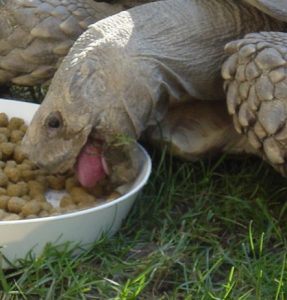In preparation for October 21st…REPTILE AWARENESS DAY, I thought I’d share the basic 4-1-1 those of you who care for our friends who crawl need to know! HERPETOLOGY is the study of reptiles & amphibians. The word comes from the Greek word “Herpeton” meaning “crawling things.”
Reptiles, like Amphibians, are vertebrates and ectotherms (cold-blooded) meaning they don’t use energy to maintain the higher metabolic rates of birds and mammals. Instead, they convert much of their energy into growth and reproduction, and since they are more energetically efficient, reptiles are more numerous than other vertebrates within most ecosystems. Yet, many species are secretive and are rarely seen by humans. Some reptiles are predators while others are prey.
Reptiles have 3 basic body types:
- Long bodies with clearly defined tails such as crocodiles (strong limbs) and lizards (weak limbs)
- Long bodies that taper into tails (snakes) with scales and muscles for movement
- Short thick bodies encased in shells (turtles and tortoises) with limbs to crawl and swim
Reptilian bodies are covered with scales or plates (known as scutes). Those with scales molt or shed their skin as they grow. All reptiles need sunlight for warmth since they cannot generate their own body head and require UV rays for both Calcium & Vitamin D synthesis. Reptiles have a 3-chambered heart (unlike us, our dogs and cats). They have only one ventricle, but when the heart contracts, a septum separates it so that it functions similarly to our two ventricles.
Lizards and iguanas are mostly insect eaters.
Snakes are carnivorous and have long, slender forked tongues. They can be found from the Arctic Circle to the tip of South America.
Pythons and most snakes lay eggs (oviparous) and their young free themselves with a sharp “egg tooth” located on the tip of the snout. Boa Constrictors and the Green Anaconda are Viviparous meaning they give birth to “live” young while rattlesnakes are Ovoviviparous – the give birth to live young after developing and retaining the eggs inside their body.
Snakes cannot close their eyes!
 Turtles can be carnivorous or omnivorous, but do not have teeth, rather sharp, serrated jaws. You can often distinguish males from females by the longer “fingers” on the ladies. All turtles lay eggs.
Turtles can be carnivorous or omnivorous, but do not have teeth, rather sharp, serrated jaws. You can often distinguish males from females by the longer “fingers” on the ladies. All turtles lay eggs.
Unlike a snail however, a turtle cannot trade out one shell for another if it no longer fits or gets damaged. Turtle shells do not fall off but rather, they grow with the turtle. Shells are made from the turtle’s rib cage and spine attached to the internal bones. It’s like our skeleton, but on the outside and plays an important role in protecting our turtle friends. They do require calcium for the shell to properly grow just like mammals need it for their bones. Scutes, the keratin plates, do however fall off or shed making room for new and larger ones.
INTERESTING FAQs
- Biggest (Most Massive) reptile – the estuarine crocodile (over 23 ft long).
- Smallest reptile (and smallest lizard) – the British Virgin Islands gecko (only 7/10 inches long)
- Fastest reptile – the spiny-tailed iguana (tracked at 21 mph)
- Biggest (heaviest) snake – the anaconda of South America.
- Longest Snake – reticulated Python (over 10 m long)
- Fastest-moving snake – probably the poisonous black mamba
- Biggest lizard – the Komodo dragon (up to 3 m long)
- Biggest turtle – the Leatherback turtle (up to 2.5 m)
- Most poisonous land snakes – the Taipan (from Australia), black mamba, and krait.
- Only poisonous lizards – the Gila monster, the beaded lizard
- Weirdest ability – Horned lizards can squirt a thin spray of blood from their eyes up to of 3 feet away
Alligators and Caiman differ from Crocs in the way their teeth fit into their jaws. Crocodiles have a 4th tooth visible when their mouth is closed.
REPTILE FIRST AID
Now let’s talk about how to care for those Reptiles you are most likely to share your habitat with. The most important tip in Reptile First-Aid is to prevent injury and trauma from happening in the first place, so properly feed and house your pet. This book however, deals with those moments in time when the whole family may be facing an emergency situation, so injuries can occur when chaos erupts and an urgent need to evacuate prevails. Have on hand an alternate container to transport your reptile should the glass aquarium break or you find it too heavy or dangerous to move. Plastic storage-type containers (with holes pierced in the lid) or even an old suitcase with punched out air holes can serve as temporary housing. If you have nothing else at your disposal, carefully transport your reptile in a securely tied pillowcase taking care no one sits on or places anything on top of your friend.
When sharing your life with an exotic pet, you are strongly encouraged to learn – BEFORE you need to know — as much as you can about emergency care of your particular species. It’s also a good thing to have your herpetologist veterinarian on speed dial should the worst happen.
Signs Requiring Veterinary Attention:
- Cold to the touch (increase housing to 85-90°F with heat lamp or other means)
- Weak and not eating
- Has a prolapse (tissue hanging out of rear or vent – cover with water-based lubricant or saline solution and get to vet)
- Appears paralyzed (do not handle but seek vet care)
Burns
Most reptiles require supplemental heat but they can get burned if they get too close to the source. Take care in setting up cages and aquariums to provide a buffer from lamps and electricity. Clean burns with chlorhexidine or diluted povidone solution (see below) and contact your veterinarian as burns can easily become infected and some reptiles pass away from serious burns.
Cuts, Scrapes & Improper Handling
Reptiles fed live prey often get bitten and scratched by their dinner. Clean wounds thoroughly with chlorhexidine (antibacterial cleanser) or diluted povidone iodine solution (mixed with water till the color of iced tea). Topical antibiotic cream can be gently applied and wound left open to heal. Some injuries however, can be severe and require veterinary suturing or medications.
Lizards improperly grabbed by their tail may lose the appendage. An open wound forms at the stump and should be cleaned as mentioned above. In time the tail most likely will regrow but will never look like the original tail, so always – even during an emergency – take time to calmly and properly handle pets.
During some types of trauma, your turtle or tortoise’s shell could crack! Clean the wound as mentioned above and call your exotic veterinarian. You may be advised to cover the shell with non-porous tape to protect internal organs.
Heat Loss
Many reptilian pets require supplemental heat and specialized lighting that may go out if you suffer a power outage. Be sure to have back-up battery powered heat lamps and basking lights. If not available, move cages to the one area family is congregating with generator supplied heating to keep all warm. Getting too cold is life-threatening to your reptilian friend.
 You can find both Amphibian and Reptile First Aid tips in the back of “The Pet Safety Crusader’s My Pet & Me Guide to Disaster PAWparedness.“
You can find both Amphibian and Reptile First Aid tips in the back of “The Pet Safety Crusader’s My Pet & Me Guide to Disaster PAWparedness.“
Watch the VLOG on this topic at: https://youtu.be/r66KlrsMvew
For 20 years Denise Fleck’s Sunny-dog Ink motto has been “Helping people to help their pets,” and she has…personally having taught close to 20,000 pet lovers animal life-saving skills and millions more on “The Doctors,” CNN, “Kirstie Alley’s Big Life,” Animal Planet and other TV shows. Denise is a frequent conference speaker, developed a line of pet first aid kits, written a dozen books and now offers classes online.
Note: The articles on this page are copyrighted. Please do not reprint or use portions for any purpose without written permission from the author. Request permission for usage by sending an email explaining how you’d like to use the materials and what parts specifically. Thank you in advance!








